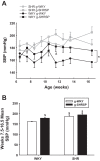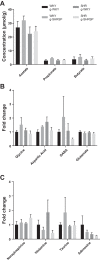Alterations in the gut microbiota can elicit hypertension in rats
- PMID: 28011881
- PMCID: PMC5336599
- DOI: 10.1152/physiolgenomics.00081.2016
Alterations in the gut microbiota can elicit hypertension in rats
Abstract
Gut dysbiosis has been linked to cardiovascular diseases including hypertension. We tested the hypothesis that hypertension could be induced in a normotensive strain of rats or attenuated in a hypertensive strain of rats by exchanging the gut microbiota between the two strains. Cecal contents from spontaneously hypertensive stroke prone rats (SHRSP) were pooled. Similarly, cecal contents from normotensive WKY rats were pooled. Four-week-old recipient WKY and SHR rats, previously treated with antibiotics to reduce the native microbiota, were gavaged with WKY or SHRSP microbiota, resulting in four groups; WKY with WKY microbiota (WKY g-WKY), WKY with SHRSP microbiota (WKY g-SHRSP), SHR with SHRSP microbiota (SHR g-SHRSP), and SHR with WKY microbiota (SHR g-WKY). Systolic blood pressure (SBP) was measured weekly using tail-cuff plethysmography. At 11.5 wk of age systolic blood pressure increased 26 mmHg in WKY g-SHRSP compared with that in WKY g-WKY (182 ± 8 vs. 156 ± 8 mmHg, P = 0.02). Although the SBP in SHR g-WKY tended to decrease compared with SHR g-SHRSP, the differences were not statistically significant. Fecal pellets were collected at 11.5 wk of age for identification of the microbiota by sequencing the 16S ribosomal RNA gene. We observed a significant increase in the Firmicutes:Bacteroidetes ratio in the hypertensive WKY g-SHRSP, as compared with the normotensive WKY g-WKY (P = 0.042). Relative abundance of multiple taxa correlated with SBP. We conclude that gut dysbiosis can directly affect SBP. Manipulation of the gut microbiota may represent an innovative treatment for hypertension.
Keywords: dysbiosis; hypertension; microbiota; short chain fatty acids; spontaneously hypertensive rat.
Copyright © 2017 the American Physiological Society.
Figures







References
-
- Campbell JM, Fahey GC Jr, Wolf BW. Selected indigestible oligosaccharides affect large bowel mass, cecal and fecal short-chain fatty acids, pH and microflora in rats. J Nutr 127: 130–136, 1997. - PubMed
Publication types
MeSH terms
Grants and funding
LinkOut - more resources
Full Text Sources
Other Literature Sources
Medical

